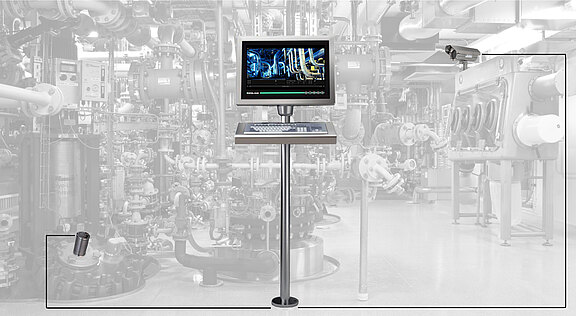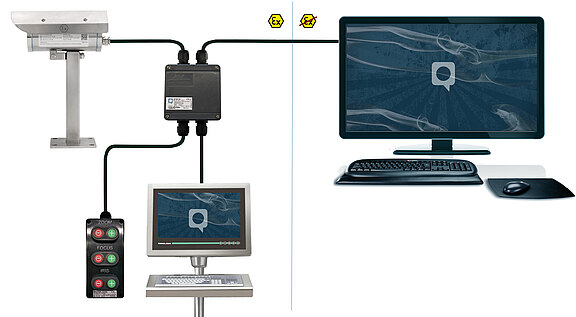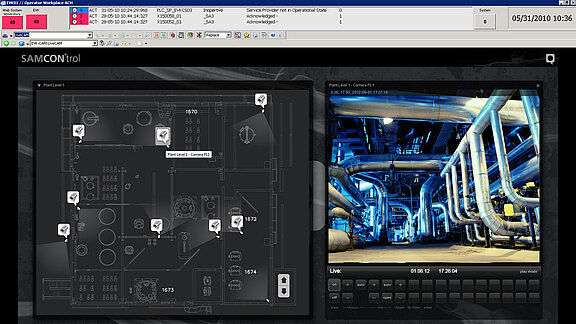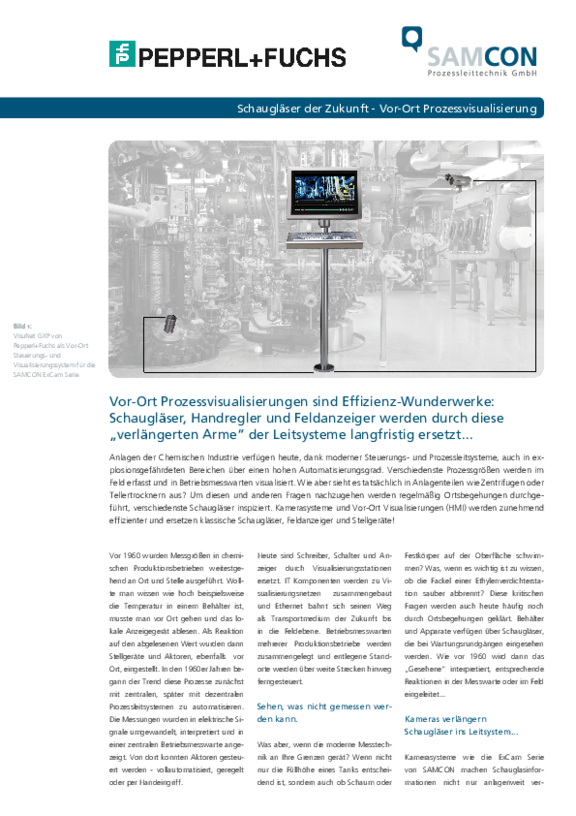Future Sight Glasses - On Site Process Visualization
On-site process visualizations are masterpieces of efficiency:
In the long-run, sight glasses, hand controller, and field indicators will be replaced by these “extensions” of control systems…
Due to modern process control systems, today, chemical plants display a high degree of automation, also in the hazardous area. Different process parameters are recorded in the field with the visualization taking place in the control room. But how does it actually look like inside plant components such as centrifuges or disc driers? In order to clarify this as well as well other issues, on-site and sight glasses inspections are conducted periodically. As camera systems and on-site visualization (HMI) have become more and more efficient, though, they start replacing standard sight glasses, field devices, and actuators.
Prior to 1960, in the chemical industry the execution of measurements took predominantly place at the applicable site location. If, for example, the temperature in a tank had to be determined, someone had to physically go there to read the applicable display value. Corresponding to the received values, control devices and actuators were adjusted; this also happened at the applicable location. In the 1960’s, the automation of processes started, first by the means of centralized, later via decentralized, process control systems. The measuring results were transformed into electrical signals, interpreted, and displayed in a central control room from where it was possible to adjust e.g. actuators – all this happened either entirely automatically, controlled, or by a manual intervention. Today, recorder, control switches, and displays have been replaced by visualization units. Furthermore, IT components are many times combined to form complete visualization networks and Ethernet has become the transmission medium even on field level. Control stations of several production sites merge and remote areas are controlled from far away control stations.
Seeing what cannot be measured.
But what if modern measurement technology reaches the limit? What if not a tank’s filling level is the decisive factor but if there is foam visible, or if solid objects float on the surface? What, if it is important to know if the flame of an ethylene compressor station burns properly? Many times - even today - such critical questions are still answered by on-site visits. Vessels and containers have sight glasses which are used for inspection during the applicable maintenance tours. Just as prior to 1960, what is viewed is interpreted and at the control station or in the field, the necessary measures are initiated.
Cameras extend the range of the sight glasses into the control system...
Camera systems such as SAMCON’s ExCam Series do not only allow for sight glass information to be widely available – they also increase the level of information:
On-site process visualizations are masterpieces of efficiency: Explosion proof cameras can be used under most difficult process conditions. It is possible to manage very high as well as very low process temperatures but also to compensate low process illumination. Modern Ex-cameras can actually gather more information than the human eye os able when looking through a sight glass and via TCP/IP this information can be made available to every operator within the PCS. This means that cameras extend the possibilities which are offered by sight glasses into the process control system!
...and the HMI systems extend the process control system into the field!
But how can the above described chain of „seeing - interpreting - reacting„ be implemented in the field? Many times, this is still be done by the means of manual control devices or via telephone consultation with the control room. However, particularly manual control devices bear, with regard to process control, a risk because their current condition is not necessarily known to the process control system: How sensible it is, for example, to open a magnet valve in the PCS when the manual slide, located behind, is closed? Modern on-site control systems, e.g. the VisuNet GXP System by Pepperl+Fuchs solve this issue! The CPU, which is remarkably powerful for Thin-Client solutions, is not only able to extend control system visualization of renowned PCS manufacturer into the field but can also transfer video streams of ExCam Series cameras delay-free allowing also their control!
Advantages of a homogeneous operating philosophy
Is a manual slide still necessary when via an HMI system, implemented on-site, the magnet valve can be controlled?
How sensible is a process sight glass still, when the „sight glass information“ is available within the entire process control system – in real time and throughout the entire plant?
With HMI systems established in the field, terms such as on-site or PCS interventions lose their importance. Thanks to the complete networking of all PCS participants, in the future it will not be important anymore where the plant is operated. With mobile as well as stationary on-site control panels, this question becomes irrelevant and cameras will lose their specific status among the PCS devices. They turn into process control sensors and are from now on available where process cameras should have been situated from the get-go: Within the process control system.
Conclusion.
With its high-performance, the VisuNet GXP System of Pepperl+Fuchs sets new standards for HMI systems located in the field: For the first time it is powerful enough to transfer the visualization level of the PCS into the field und to visualize controllable video streams of the ExCam Series without any delay. Both device series are certified to be used in hazardous areas (gas and dust) of zones 1/2 and 21/22 according to ATEX and IECEx. The combination of the SAMCON ExCam Series and the Pepperl+Fuchs VisuNet GXP reflects the „sight glass of the future“:
On-site information is available within the entire process control system – PCS information is available on-site.




